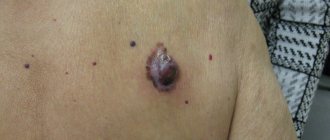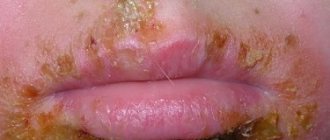Quick transition Treatment of cutaneous lupus erythematosus
Systemic lupus erythematosus is treated by a rheumatologist. During therapy with antimalarial drugs (hydroxychloroquine, chloroquine), observation by an ophthalmologist is necessary. If you suspect the development of squamous cell skin cancer against the background of discoid lupus erythematosus, consultation with an oncologist is necessary.
Lupus erythematosus rashes on the skin and/or mucous membranes can be an independent disease or a manifestation of systemic lupus erythematosus, a chronic disease associated with the formation of antibodies to components of cell nuclei. Antibodies cause damage and inflammation of various tissues, including the skin.
Drug-induced lupus
About 10% of people with SLE experience symptoms due to a reaction to certain prescription drugs. According to Genetics Home Reference
, about 80 drugs can cause this condition.
These include some of the drugs that people use to treat hypertension. They also include some thyroid medications, antibiotics, antifungals, and oral contraceptives.
Medicines that are commonly associated with this form of lupus:
- Hydralazine;
- Procainamide;
- Isoniazid.
Drug-induced lupus usually goes away after a person stops taking the drug.
Treatment
Treatment of discoid lupus erythematosus is largely determined by its clinical form and causative factors contributing to the progression of the disease. Therapy begins with the elimination of infectious foci and correction of endocrine disorders. It is very important, if possible, to stop taking photosensitizing medications and eliminate existing allergic manifestations.
It is also recommended to avoid direct sunlight on the skin and use reflective ointments based on titanium dioxide, Mexoril or zinc oxide when going outside. Products such as Methyluracil, Salol, Quinine, and Fencortosol have photoprotective qualities. Biyoquinol can be applied to the areas affected by the rash.
When applied topically, Methyluracil has an anti-inflammatory and photoprotective effect.
Doctors often prescribe local combination therapy: photoprotective ointments are used in the morning, and hormonal ointments containing corticosteroids are used in the evening.
Aminocholine antimalarial drugs - Khingamin, Delagil, Chloroquine, Rezoquine - show maximum effectiveness for DLE. These medications are taken in a course and the dosage is reduced every ten days. During the first ten days they drink 250 mg twice a day, the next 10 days - once a day, then every other day.
Plaquenil has the ability to suppress an excessive immune reaction, which doctors often supplement the therapeutic regimen with. You can drink it up to 4 times a day. During therapy, it is necessary to remember the possible development of side effects. In order to make timely adjustments to treatment, blood and urine are regularly taken from the patient. Taking Hydroxychloroquine can negatively affect the condition of the blood vessels of the eyeball, so patients should be observed by an ophthalmologist.
Neonatal lupus
Most babies born to mothers with SLE are healthy. However, about 1% of women with lupus autoantibodies will have a child with neonatal lupus. Sjögren's syndrome is another autoimmune condition that is common with lupus. The main symptoms include dry eyes and dry mouth.
At birth, babies with neonatal lupus may have skin rashes, liver problems, and low blood pressure. About 10% of them suffer from anemia.
The lesions usually resolve within a few weeks. However, some babies have cardiac problems and the baby may need a pacemaker. This can be a life-threatening condition. Women with SLE or other related autoimmune diseases require constant medical supervision during pregnancy.
Causes
Discoid lupus erythematosus is an autoimmune pathology: due to disruption of T- and B-lymphocytes, a lot of antibodies are formed that mistakenly attack the body’s own cells. The result of their uncontrolled and excessive production is the appearance of specific complexes that spread throughout the body.
Scientists believe that one of the main factors contributing to the occurrence of DLE is genetic predisposition, since the disease often occurs in close relatives.
Currently, the exact cause of lupus has not been established, and research on this issue continues. The most promising theories about the viral and streptococcal origin of the disease were not confirmed, although cytopathogenic viruses and streptococci were found in the blood of many patients.
There is no doubt that discoid lupus erythematosus is an infectious-allergic disease of an autoimmune nature, despite the lack of accurate data on the mechanism of its origin and development. In blood tests of patients, many gamma globulins are present, and in the bone marrow - pathologically altered cells. Most patients experience endocrine and metabolic disorders.
Very often, the trigger that disrupts the immune system is ultraviolet irradiation or local exposure to low temperatures and frostbite of the skin.
Risk factors also include the following:
- frequent trauma to the skin;
- chronic infections;
- allergic reactions;
- treatment with drugs that cause photosensitivity (sensitivity to light). These may be sulfonamides, antipsychotics, tetracycline, fluoroquinolones or the antibiotic Griseofulvin;
- professional activities associated with prolonged exposure to the street. When working in the field or at a construction site, a person receives a significant dose of radiation, especially in the summer;
- Scandinavian (Celtic) skin type, the owners of which are most sensitive to the effects of ultraviolet and other visible radiation.
The discoid type of lupus differs from the systemic one in that pathological reactions occur only on the skin. However, the basis of the pathology is autoimmune inflammation. Under the influence of ultraviolet radiation in combination with other provoking factors, the molecular structure of DNA changes in skin cells. As a result, the activity of proteins that promote cell destruction increases.
Working in the field under the scorching sun can cause a malfunction of the immune system and the development of autoimmune inflammation.
B and T lymphocytes activate the production of cytokines (molecules that transmit information) and antibodies to elements of cell nuclei - structural parts of chromosomes and nucleic acids. The resulting immune complexes settle on the walls of blood vessels and damage them.
The synthesis of aggressive antibodies in people with a hereditary predisposition can also be caused by antigens of cytomegalovirus, herpes virus, and DNA-containing parvovirus B19. The molecular structure of all these viruses has significant similarities with cell membrane proteins.
An additional damaging factor is the oxidative degradation of lipids under the influence of free radicals. The result of these processes is large-scale inflammation and death of epidermal cells.
Causes of lupus
The immune system protects the body and fights antigens such as viruses, bacteria and germs. It does this by producing proteins called antibodies. White blood cells or B lymphocytes produce these antibodies. When a person has an autoimmune condition such as lupus, the immune system cannot distinguish between unwanted substances, antigens, and healthy tissue. As a result, the immune system directs antibodies to both healthy tissue and antigens. This causes swelling, pain and tissue damage. The most common type of autoantibody that develops in people with lupus is antinuclear antibody (ANA). These autoantibodies circulate in the blood, but some of the body's cells have walls that are permeable enough to allow some autoantibodies to pass through.
Autoantibodies can then attack the DNA in the nucleus of these cells. Several genetic factors likely influence the development of SLE.
Some genes in the body help the immune system function. In people with SLE, changes in these genes can interfere with the functioning of the immune system. One possible theory involves cell death, a natural process that occurs when the body renews its cells, according to Genetics Home Reference
.
Some scientists believe that due to genetic factors, the body does not get rid of dead cells. These dead cells that remain can release substances that cause the immune system to malfunction.
1.What is lupus and its types
Lupus is an autoimmune disease. The term "autoimmune" means that the body's immune system mistakenly perceives its own tissues as foreign and begins to attack them. Lupus is one such disease. Some people with lupus experience only minor discomfort. For others, the disease means lifelong disability.
Statistically, 9 out of 10 people with lupus are women. The disease usually strikes between the ages of 15 and 45, although it can also begin in old age.
There are two types of lupus:
- Discoid lupus erythematosus;
- Systemic lupus erythematosus.
Discoid lupus erythematosus,
mainly affects skin that is not protected from sunlight, and usually does not affect vital internal organs. In discoid lupus erythematosus, disc-shaped (round patches) of lesions form on the skin and may leave scars after they heal.
Systemic lupus erythematosus
- a more serious problem. This disease affects both the skin and vital organs. In addition to a severe rash on the cheeks and bridge of the nose that leaves scars if left untreated, systemic lupus erythematosus can cause rashes on other parts of the body. But this is not the most dangerous thing. In addition to a visible rash, systemic lupus erythematosus can cause inflammation and/or damage to the connective tissue in joints, muscles, and skin, as well as the membranous tissues surrounding the lungs, heart, kidneys, and brain. The brain is affected extremely rarely, but systemic lupus erythematosus can still cause confusion, depression, seizures and stroke.
Systemic lupus erythematosus can also affect blood vessels. This exposure leads to the appearance of ulcers on the skin, especially on the fingers. Some people may develop Raynaud's syndrome,
when small blood vessels in the skin become blocked and prevent blood from flowing to the arms and legs. This happens more often in the cold. This situation usually lasts a few minutes, and the arms and legs may be painful and turn white or slightly bluish. People with systemic lupus and Raynaud's syndrome should always wear gloves and warm clothes and shoes during the cold season.
A must read! Help with treatment and hospitalization!
Risk factors: hormones, genes and environment
Lupus can develop in response to a number of factors. They may be hormonal, genetic, environmental, or a combination of these.
The US National Institutes of Health notes that women are nine times more likely to have lupus than men. Age: Symptoms and diagnosis often begin between the ages of 15 and 45. However, 20% of cases appear after age 50, according to Genetics Home Reference.
Since 9 out of 10 cases of lupus affect women, researchers are looking at a possible connection between estrogen and lupus. In a review published in 2020, scientists noted that estrogen can influence immune activity and induce lupus antibodies in mice that are susceptible to lupus. This may explain why autoimmune diseases affect women more often than men.
There is not yet enough evidence that estrogen causes lupus. If there is a link, estrogen-based treatments may regulate the severity of lupus. However, more research is needed before doctors can suggest it as a treatment.
Researchers have not proven that any specific genetic factor causes lupus, although it is more common in some families.
A person who has a first- or second-degree relative with lupus will have a higher risk of developing it.
Scientists have identified genes that may contribute to the development of lupus, but there is not enough evidence that they cause the disease.
General information about the disease
Systemic lupus erythematosus is a chronic disease characterized by severe skin manifestations. The exact etiology of the inflammatory process has not been established; a connection with disorders of autoimmune processes has been proven. Against their background, the body's cells produce antibodies to their own tissues. If a patient has lupus erythematosus, diagnosis is achieved through the joint efforts of a dermatologist and rheumatologist. The diagnosis is confirmed after obtaining the results of laboratory tests and assessing the main clinical signs.
Symptoms of lupus erythematosus:
- swelling of the joints, accompanied by pain;
- increased body temperature;
- increased fatigue or chronic fatigue;
- red rashes on the face, change in skin color;
- pain in the chest when taking a deep breath;
- active hair loss, formation of bald patches;
- blue hands and feet due to cold and stress;
- puffiness around the eyes;
- increased skin sensitivity to ultraviolet radiation;
- enlarged lymph nodes.
The main signs of lupus are dermatological. A person develops a rash on the cheeks and bridge of the nose, the body becomes covered with extensive red spots, and nails become brittle. In advanced cases, trophic ulcers form. The mucous membranes suffer, ulcers appear on the red border of the lips, and erosions form in the oral cavity.
The disease is classified according to its stages:
- acute form. Characterized by a malignant course with continuously worsening symptoms. The disease is resistant to medication. This type is typical for children;
- subacute form. Periodic exacerbations occur, but symptoms are moderate. Complications in the form of organ damage appear a year later;
- chronic form. Characterized by the long-term manifestation of one or more symptoms.
During the inflammatory process, there are three main stages. The first one is minimal. It is characterized by mild pain, periodic increases in body temperature, and weakness. Skin signs are slightly isolated. At a moderate stage, damage to the face and body is observed; blood vessels and joints are involved in the process, and damage to internal organs is possible. At an advanced stage, complications appear in the functioning of internal organs. Damage to the brain, circulatory system and musculoskeletal system is possible.
The causes of lupus are not clear. Lymphocytotoxic antibodies, which are characteristic of a persistent viral infection, are detected in patients and their relatives. Virus-like inclusions are present in the endothelium of tissues of damaged organs. The disease is widespread among women aged 20-40 years, but there are cases of its detection in older people, adolescents and children. Among men, SLE is less common, the frequency reaches 10% of the total number of cases. Stress is identified as a provoking factor. It is possible that SLE may develop as an allergic reaction that occurs after long-term use of medications.
There are no specific preventive recommendations. They boil down to general rules:
- eliminate the effects of stress;
- avoid prolonged contact with direct sunlight;
- Healthy food;
- treat infectious and inflammatory diseases;
- do physical education;
- stop taking oral contraceptives with a high proportion of estrogen.
The prognosis for patients with systemic lupus erythematosus is poor. Irreversible changes occur in the body, affecting all organs, and multiple organ failure develops. Once the symptoms of lupus disease appear, the patient can live more than 20 years thanks to recent medical advances.
Environment
Environmental agents, such as chemicals or viruses, can trigger lupus in people who are already genetically susceptible.
Possible environmental triggers include:
- Smoking: The increase in incidence in recent decades may be due to higher levels of tobacco exposure.
- Exposure to sunlight: Some believe this may be a trigger.
- Drugs: About 10% of cases may be related to drugs, according to Genetics Home Reference.
- Viral infections: This can cause symptoms in people who are prone to SLE.
Lupus symptoms
Lupus symptoms occur during flares. Between outbreaks, people usually experience periods of remission when there are few or no symptoms.
- fatigue;
- loss of appetite and weight loss;
- pain or swelling in joints and muscles;
- swelling in the legs or around the eyes;
- swelling of the glands and lymph nodes;
- skin rash due to bleeding under the skin;
- mouth ulcers;
- sensitivity to the sun;
- fever;
- headache;
- chest pain when breathing deeply;
- hair loss;
- Raynaud's syndrome;
- arthritis.
Symptoms
The first signs of discoid lupus are pink-red, slightly swollen spots, usually on the face. Subsequently, they are transformed into dense plaques with multiple scales that frame the bases of the hair follicles. Trying to scrape off the scales causes pain, and after removing them, the skin becomes like a lemon peel.
Since the disease is chronic, over time the number of red spots increases, covering an increasing area of the skin. Infiltrates, increased pigmentation and keratinization of the dermis may occur along the edges of the plaques.
In the center of each pathological focus, the skin begins to atrophy and become thinner. The stratum corneum of the skin inside the hair follicles, on the contrary, thickens, which leads to their clogging with keratin. The affected skin takes on a “goose bump” appearance, and uneven pigmentation is observed along the edges of the plaques. Often, plugs form in the ducts of the sebaceous glands on the skin next to the ear canal, and the top layer of skin has the appearance of a thimble.
White-skinned people with blond and red hair are much more sensitive to the effects of visible radiation and extreme temperatures.
Damage to the scalp in almost all cases is accompanied by alopecia - irreversible hair loss, leading to baldness. In addition, scars form in place of lost hair.
Sometimes symptoms of discoid lupus erythematosus may include ulcerative lesions of the oral mucosa and deterioration of the nails. Nails turn yellow and become brittle, often deformed. When plaque forms in the mouth, chewing food causes burning and pain.
In rare cases, DLE affects the organs of vision, leading to inflammation of the cornea, eyelids, or conjunctiva of the eyes. Most often, erythematous spots are located on the face in the form of a butterfly, covering the nose and most of the cheeks.
It should be noted that discoid lupus erythematosus very rarely causes complications. Sometimes secondary granular cheilitis can develop - damage to the salivary glands in the Klein zone, at the border of the red border of the lips. Cheilitis is manifested by increased salivation, peeling and cracking of the skin on the lips. Some patients complain of itchy lips.
The disseminated form of DLE can transform into systemic lupus, which affects joint structures and vital organs: the heart, kidneys, liver, lungs and central nervous system. The systemic disease is dangerous because it is difficult to treat and has a poor prognosis. Despite the successes and latest developments in medicine, high activity of the disease can lead to the death of the patient.
One of the possible consequences of discoid lupus may be the degeneration of pathological erythematous lesions into squamous cell skin cancer. In this case, keratinocytes, which form the basis of the epidermis, form a malignant tumor - squamous cell carcinoma (SCC).
Effect on other body systems
Lupus can also affect the following systems:
Kidneys
: inflammation of the kidneys (nephritis). 1 in 3 people with lupus have kidney problems. Lungs: Some people develop pleurisy, which causes chest pain, especially when breathing. Pneumonia may develop.
Central nervous system:
lupus can sometimes affect the brain and central nervous system. Symptoms include headaches, dizziness, depression, memory problems, vision problems, seizures, stroke or behavioral changes.
Vasculitis, or inflammation of the blood vessels, may occur. This may affect blood circulation.
Blood
: Lupus can cause anemia, leukopenia (reduced number of white blood cells), or thrombocytopenia (decreased number of platelets in the blood, which help blood clot).
Heart
: If inflammation affects the heart, it can lead to myocarditis and endocarditis. It can also affect the lining that surrounds the heart, causing pericarditis. Chest pain or other symptoms may occur. Endocarditis can damage the heart valves.
Diagnostics
To confirm discoid lupus erythematosus, laboratory and instrumental diagnostics are prescribed. It includes:
- examination of the patient - the doctor assesses the condition of the skin, notes the characteristic signs of the disease;
- history data - discoid lupus is prone to inheritance, identifying this fact confirms the doctor’s fears;
- blood test - the analysis shows signs of inflammation in the form of an increase in the erythrocyte sedimentation rate and a shift in the leukocyte formula to the left;
- rheumatological tests - many patients with discoid lupus have specific antibodies to nucleoproteins in their blood;
- biopsy - taking material for histological examination.
When studying the skin under a microscope, the death of the integumentary epithelium, proliferation of the stratum corneum, swelling and destruction of collagen fibers are noted. If the results of most studies coincide, a diagnosis of discoid lupus is made and therapy is prescribed.
Other complications
Having lupus increases your risk of a number of health problems:
Infection
: Infection becomes more likely because lupus also weakens the immune system. Common infections include urinary tract infections, respiratory infections, yeast infections, salmonella, herpes. Bone osteoporosis: This occurs when the blood supply to the bone is reduced. Eventually, the bone may break down. This most often affects the hip joint.
Pregnancy complications: Women with lupus have a higher risk of pregnancy loss, premature birth, and preeclampsia, a condition that includes high blood pressure. To reduce the risk of these complications, doctors often recommend delaying pregnancy until lupus has been under control for at least 6 months.
3.Diagnosis of lupus
Lupus, including systemic lupus erythematosus, is a difficult disease to diagnose because its symptoms can be very vague. And unlike many other diseases, lupus cannot be diagnosed with a single laboratory test. However, laboratory tests can help confirm the diagnosis of lupus (systemic lupus erythematosus) and monitor the progress of treatment.
Blood tests to diagnose lupus:
- Antinuclear antibodies - ANA
. This is one of the types of antibodies that act against cell nuclei. Almost all people with active lupus have ANA. But the peculiarity is that a positive test result does not always indicate lupus. Therefore, such an analysis cannot be the only criterion for diagnosing lupus. - Antiphospholipid antibodies - APL.
Such antibodies act specifically against phospholipids. APLs are present in approximately 60% of people with lupus, and their presence can help confirm the diagnosis. This blood test is usually done in women with suspected lupus when prophylaxis and monitoring for risk of thrombosis, miscarriage, or preterm birth are needed. But as in the previous case, APL can end up in the blood of people without lupus. - Anti-Sm
is another group of antibodies that target a specific protein in the nucleus of cells. These antibodies are very rare in people who do not have lupus. But on the other hand, only 30% of sick people have them. - The anti-dsDNA test
is positive in 75-90% of people with lupus. Overall, this is a very specific study. Often the titer (or antibody level) in patients increases as the disease gets worse, so this test can be used to assess disease activity. In addition, the presence of such antibodies indicates a high risk of kidney inflammation due to lupus. As with previous cases, this blood test is not an absolute criterion for diagnosing lupus—25% of people with lupus test negative.
In addition to these and other blood tests for antibodies, a comprehensive diagnosis of lupus uses blood tests to determine the presence of an inflammatory process in the body, determination of erythrocyte sedimentation rate, general blood tests to determine the content of various types of cells, biochemical blood tests, and urine tests.
to evaluate the effect of lupus on the kidneys. Each individual study cannot serve as a basis for making a diagnosis of lupus, systemic lupus erythematosus. But taken together, the diagnostic result can be quite accurate.
In any case, when diagnosing lupus, doctors will rule out other diseases that can cause similar symptoms - rheumatoid arthritis, infections, cancer and others.
About our clinic Chistye Prudy metro station Medintercom page!
Treatment and home remedies
There is currently no cure for lupus, but people can manage their symptoms and outbreaks with lifestyle changes and medications.
Goal of treatment:
- prevent or control outbreaks;
- reduce the risk of organ damage.
Medicines can help:
- reduce pain and swelling;
- regulate the activity of the immune system;
- balance hormones;
- reduce or prevent damage to joints and organs;
- manage blood pressure;
- reduce the risk of infection;
- control cholesterol.
The exact treatment will depend on how lupus affects a person. Without treatment, flare-ups can occur, which can have life-threatening consequences.
Treatment of cutaneous lupus erythematosus
The basis of treatment is corticosteroid hormones. With this disease, they can be applied to the lesions in the form of ointments, or injected directly into the lesion of the affected skin. In severe cases, systemic corticosteroids may be prescribed. As an alternative or to enhance therapy, it is possible to apply calcineurin inhibitors to the lesions.
In cases of severe skin damage and insufficient effect of external treatment, systemic therapy is carried out using antimalarial drugs (chloroquine, hydroxychloroquine), anti-inflammatory drugs (methotrexate, mycophenolate, dapsone, azathioprine, etc.).
Features of the treatment method
The first line of treatment is topical corticosteroids and hydroxychloroquine.
To reduce the total dose and side effects of topical corticosteroids, calcineurin inhibitors are included in treatment.
During treatment with hydroxychloroquine, regular medical supervision is necessary. The condition of the retina must be monitored, since the drug can impair vision with long-term (more than 5 years) use. This side effect is uncommon, but signs of retinal damage may require discontinuation of the drug.
Intralesional administration of drugs (corticosteroid hormones) using multiple superficial injections directly into the lesion of the affected skin allows you to create a high concentration of the drug in the lesion, while reducing the risks of systemic side effects. The medicine is administered by a doctor in a dressing room to a depth of 2-3 mm. The procedure is painful, but the pain is not sharp and largely depends on the sensitivity of the patient’s receptors. To reduce pain, a thin needle is used, and an anesthetic ointment may be used.
All patients must be prescribed skin protection against ultraviolet radiation.
How is lupus erythematosus treated at the Rassvet clinic?
The dermatologist will ask you to talk about the course of the disease and the treatment that was carried out previously. The doctor will examine the skin (including the scalp) and mucous membranes. Dermatoscopy and trichoscopy can be informative. With this disease, to establish a diagnosis in most cases, a skin biopsy will be required with an additional immunofluorescence reaction.
If cutaneous lupus erythematosus is suspected, it will be necessary to discuss the possibility of systemic manifestations and assess the condition of other organs and systems of the body. Additional studies may be required to identify a systemic process (blood tests, urine tests, etc.).
Forecast
People who have a history of lupus do not usually survive more than 5 years. Now, however, the treatment can significantly increase a person's life expectancy, according to the National Institutes of Health.
Effective therapy can also help manage lupus so a person can live an active, healthy life.
As scientists learn more about genetics, doctors hope they will one day be able to identify lupus at an earlier stage. This will make it easier to prevent complications before they occur.
Scientists believe that lupus increases the risk of developing cervical cancer in women.
Lupus and pregnancy
When lupus is diagnosed, pregnancy planning should be carefully discussed with doctors and special tests should be performed.
A diagnosis of lupus does not mean that a woman will not be able to become pregnant, however, the disease increases the risk of spontaneous abortion, and its symptoms worsen during pregnancy. Lupus is extremely rare in children and infants.
ONLINE REGISTRATION at the DIANA clinic
You can sign up by calling the toll-free phone number 8-800-707-15-60 or filling out the contact form. In this case, we will contact you ourselves.
If you find an error, please select a piece of text and press Ctrl+Enter











